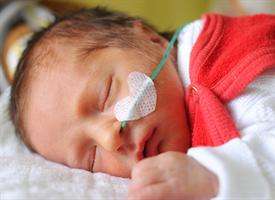Infant nose, lung cells possess remarkably similar RNA patterns

Cells from an infant's nose are remarkably similar to those found in the lungs, a discovery that could lead to much more precise diagnosis of respiratory syncytial virus (RSV) and other infant lung diseases, according to new research from the University of Rochester Medical Center (URMC).
The study, published in Scientific Reports, provides a potential avenue for diagnosis that has challenged physicians for years, as infants with respiratory disease are usually so fragile that attempting to obtain lung samples is unsafe. Nasal cells, however, can be captured through a simple swab of the nostril, and, their similarity to lung cells on an RNA level would allow physicians to get an accurate representation of how the lung is responding during disease states, without the need for more invasive tests.
"An infant with RSV could potentially have their nasal cells tested to determine if they are among the small group that will develop a severe response that might require hospitalization," said Thomas Mariani, Ph.D., professor of Pediatrics at URMC. "Additionally, we could potentially use this method to examine other at-risk infants, such as those born prematurely who face a greater risk for lung disease throughout life—and identify which of those children should be treated more aggressively."
The research also carries tremendous promise for future studies. While scientists have made significant progress over the past several decades to better understand adult lung diseases—such as chronic obstructive pulmonary disease and lung fibrosis—discovery has not been nearly as robust for infant diseases, due to the risks involved in securing lung tissue.
But the relative ease of obtaining nasal cells could accelerate understanding of how infant lungs respond to RSV and other diseases. While this study examined 53 healthy infants as a means of establishing a benchmark for normal cell structure, researchers at URMC have already begun studying the nasal tissue of diseased infants. Early results are promising.
"We're actively working on studies in infants with lung diseases, and we're showing quite clearly that we can identify differences between those with mild disease and those with more severe outcomes," said Mariani, the study's lead author.
More information: Chin-Yi Chu et al. The Healthy Infant Nasal Transcriptome: A Benchmark Study, Scientific Reports (2016). DOI: 10.1038/srep33994


















